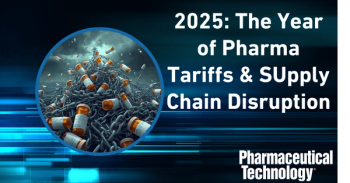
PTSM: Pharmaceutical Technology Sourcing and Management
- PTSM: Pharmaceutical Technology Sourcing and Management-09-03-2014
- Volume 10
- Issue 9
Supply Chain Security Tops Concerns for Biopharma Raw Materials
Biopharma are looking to reduce risk, increase performance, and optimize productivity in raw material development.
The drivers for the development of new raw materials are, as always, changing customer needs. At the top of the list in today’s industry, according to Douglas Bowman, program manager for PharmaGrade raw materials at SAFC, is risk reduction. Beyond that, he says that customers are looking for effective ways to increase performance and output and optimize productivity.
Supply chain security
“The demand for supply chain security and transparency continues to grow and is the number one concern of many drug manufacturers as they navigate the new market,” asserts Bowman. In fact, many manufacturers are still working to respond to guidelines implemented in 2012 that require final end-users to have visibility of their raw-material supply chain. “Biopharmaceutical manufacturers are faced, now more than ever, with the reality of global events that have threatened and breached supply chain security,” adds Beth Ann McLane, SAFC’s product manager for enhanced quality. Global threats to the security of the raw-materials supply chain have caused a public outcry, and regulatory bodies have demanded higher levels of compliance. “Manufacturers are now being held fully responsible for the raw materials that go into their products and they simply do not have enough capacity to test for all of the possible contaminants that could find their way into the materials,” she comments.
In response, the industry is moving towards risk assessment and risk mitigation of raw materials from the early stages of drug development. Manufacturers are looking to their raw-material suppliers to provide them with the support of a secure supply chain, according to McLane. “The more that biopharmaceutical manufacturers know about their suppliers and the raw-material supply chain, the more confident they can then be about the safety of those raw materials,” she says. Achieving this goal requires tracing these materials back to the manufacturer and demonstrating that there is a stringent change-control process in place.
Performance and productivity
At the same time, the push to reduce risk has caused many manufacturers to move away from animal-derived materials that provide high performance in cell-culture manufacturing, such as serum, which is creating additional challenges in maintaining productivity and yields. The need to optimize productivity has, therefore, led to increased scrutiny of other raw materials in the media, as well as other bioreactor supplements. “There is a much greater focus today placed on isolating extraneous matter or impurities that could have a negative effect on the performance of raw materials,” Bowman observes. “Where, as a result, having a controlled source in combination with meaningful specification is optimal.”
More demanding customers
In the past, according to Bowman, manufacturers typically asked only for the name of the source of a raw material from their supplier and considered this information to be ample identification of the “source”. Much has changed since then, because customers realize the amount of risk such an approach involves, particularly given the requirements of increasingly stringent global regulations. “Manufacturers are now looking to source higher quality--GMP or similar quality level, such as SAFC’s Elite--across the board. It is no longer just a handful of raw materials receiving attention; any material being used in drug manufacturing is receiving a greater deal of attention,” he notes.
Challenges with plant-based materials
The drive toward plant-based materials brings greater inherent variability to the table. “When something comes from the earth, there are many factors that cannot be controlled--factors that can change a material from lot to lot,” says Bowman. SAFC, as a raw-material supplier to the biopharmaceutical industry, has met this challenge by increasing its levels of testing and working to chemically define materials if possible. For those substances that cannot be chemically defined, and particularly in the case of plant-based raw materials, the company works to secure its sources and control what it can. “The rest of the process,” comments Bowman, “involves continuous learning built on research and testing of the materials that allows us to capture and analyze critical data points.”
He does stress, though, that meeting these challenges is not as simple as it may seem. SAFC, despite the difficulty, has chosen to view the situation as an opportunity. “We have worked on expanding our PharmaGrade line of high-quality, controlled, and documented materials to remove some of the pressure on manufacturers, but the process is grueling. We must identify how/where the product is made, conduct audits, establish quality agreements, ensure there is a stable change-control process, and obtain full documentation for customers, and of course, conduct extensive testing.” Through this comprehensive process, the company believes it can gain an understanding of the types and levels of contaminants associated with raw materials and use that information to mitigate their biological impact at different levels.
Assuring supply-chain transparency
SAFC’s PharmaGrade portfolio was created in response to urgent demand from customers for products they can count on to be consistent and that are from a source where the production is controlled and changes are limited, according to McLane. “These types of customers are not only looking for a guaranteed level of quality; they also want to know what is happening with the raw materials and be notified if/when any changes occur,” she observes. To provide a higher level of documentation and support, SAFC has invested significant resources into the identification and qualification of products for the line and established a strong change-control notification system.
Each product has a complete dossier of information about it, including the site of manufacture and the quality systems associated with the product. New materials must also meet seven key criteria that were developed based on customer requests and include manufacture under GMP (or SAFC’s Elite) quality guidelines, supply-chain transparency, formal vendor qualification, quality assurance review and release of each lot, change-control notifications, quality documentation, and availability as catalog items. The PharmaGrade range includes amino acids, buffers, and specialty chemicals that are widely used in biopharmaceutical manufacturing.
Raw-material characterization
SAFC has also been focused on a stringent raw-materials characterization program to improve product/media formulations that involves the identification of impurities that impact productivity and product quality. “The goal here is to test and gather enough data that we can automatically identify performance issues and correlate them to a specific raw material. We also believe that if we can fully understand the biological effects of contaminants, we can then work to identify specifications that will enable more efficient biopharmaceutical production for our customers,” Bowman explains.
On the customer side, the company is also taking time to educate customers so that they receive the grade of material that they actually need. “Our PharmaGrade raw materials are often not required for early development projects, while research-grade materials are not appropriate for commercial applications and could have grave effects on the final drug product,” he says. “We are, therefore, focused on aligning with our customers to really learn their processes and help them identify the right materials that are fit for purpose and ultimately fit for manufacturing,” he continues.
Industry actions
Supply-chain security is an issue that the entire pharmaceutical industry is grappling with. Both biologics and small-molecule pharmaceutical manufacturers, contract manufacturers, and raw-material suppliers are facing the same challenge of ensuring the quality and safety of the products they purchase and/or sell meet the standards set for drug product manufacturing and formulation.
“The industry is coming together over this issue because these challenges are not just for one manufacturer; they are challenges for all manufacturers. Finding appropriate resolutions creates great opportunity for everyone,” Bowman asserts. Groups such as Rx-360 and the Parenteral Drug Association are working to define and standardize methods for achieving supply-chain security and raw-material quality, as well as educate their members. “Such industry-wide challenges require industry-wide answers to ensure that drug manufacturers are meeting and exceeding quality standards,” Bowman says. In particular, he points to the efforts of Rx-360 to encourage the use of more effective, shared audits that would allow the industry to take a significant portion of the time spent auditing to focus on these greater challenges. On a more global scale, Bowman believes that the International Conference on Harmonization (ICH) Q3 guidelines for elemental impurities, which are under development and will update the analytical requirements for heavy metals and other contaminants, will likely result in significant changes in detection methods and limits that can help the industry streamline raw-material standards.
Meeting customer needs
In the end, raw-material development for the biopharmaceutical industry is no different than new product development in any industry with respect to the importance of determining what customers really need and then working to meet those needs with a clear, educated, scientific approach, according to Bowman. “To that end, at SAFC we have honed in on identifying product characteristics that impact the performance and consistency of the formulated products we develop. We also want to make it simple for customers by offering the most commonly used products at an exceptionally high-quality level right off the shelf in order to eliminate the need for customization,” he says.
About the Author
Cynthia A. Challener is a contributing editor at Pharmaceutical Technology.
Articles in this issue
over 11 years ago
Contract Services Ride High As Funding Floods Biopharmaover 11 years ago
Contract Providers Assume Expanded Responsibilitiesover 11 years ago
African Biopharma Market Presents Long-term Opportunitiesover 11 years ago
FDA Strategies Designed to Speed Generic Drug Approvalsover 11 years ago
Study: CMO Technical Expertise is Not Enoughover 11 years ago
Preparing to Meet Counterfeiting RegulationsNewsletter
Get the essential updates shaping the future of pharma manufacturing and compliance—subscribe today to Pharmaceutical Technology and never miss a breakthrough.




